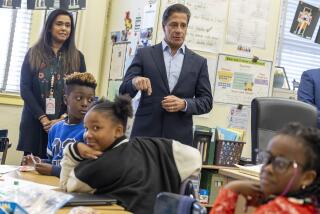Fast-Track Science
- Share via
Twenty-four of the nation’s most academically talented 13-year-olds file into a science classroom borrowed from a local high school. They have just completed a course on water safety, and they are about to begin a lesson on marine biology. “Have you heard of plate tectonics?” asks the teacher. “Yeah!” comes a chorus of voices.
“Let’s try an experiment,” the teacher says. This is music to their ears. Soon 24 curious teenagers are focusing microscope lenses on petri dishes filled with sand.
They call this summer camp?
“These kids are the intellectual promise of our country,” said Stephen Gessner, program director at the camp’s parent organization, the Institute for the Academic Advancement of Youth, based at Johns Hopkins University in Baltimore.
“If we can’t offer them the intellectual experience they need, business, government and academia will suffer,” he added.
Although it is July, these students do not seem to mind spending the day inside a science lab, learning the fundamentals of marine biology. In fact, this is exactly what 51 students bargained for when they signed up for the three-week science and math summer program called Ocean Camp, underway at various sites throughout the South Bay and Long Beach.
The program is one of 19 enrichment programs in math, science and the humanities offered around the country for the nation’s academically gifted 8- to 15-year-olds.
The hope, officials said, is to give to accelerated students in three weeks what their schools cannot provide for them in one year. “We want to offer an opportunity to the best and the brightest who may not be receiving challenging activities in school,” Gessner said.
Coordinators also aim to boost children’s interest in areas they may know little about.
“We want to whet their taste buds for science and math,” said Don Newman, director of education for the Long Beach Maritime Foundation and creator of the Ocean Camp curriculum. “Math and science are hard to get into, and the ocean certainly lends itself to doing that.”
Taught in three units, Ocean Camp introduces eighth- and ninth-graders to the basics of marine science and more. For three weeks, students take courses in naval engineering, marine biology, oceanography, boat design, meteorology, terrestrial ecology and chemistry.
The students, who are housed at Los Alamitos Naval Reserve Center, spend their days taking courses and performing fieldwork at places such as Cabrillo Marine Aquarium, Los Angeles Maritime Museum, Southern California Marine Institute, Aquarium of the Pacific in Long Beach and the Marine Mammal Care Center in San Pedro.
As nightmarish as the summer program may sound to the typical adolescent, getting through the workload is the easy part, campers say. The biggest challenge is getting into the program in the first place.
Ocean Camp and other academic programs offered by the institute are open only to the top 3% of students in their age group. In order to qualify for the first round of admissions, each student must rank in the 97th percentile or above on a nationally standardized achievement test.
But for those who make it, learning among others with similar academic abilities comes as a welcome relief.
“You’re not hanging back for the other kids to catch up,” Matt Jeglum, 13, said as he finished up a report on the composition of sand. “You’re at a place that’s right for you because everyone is smart here.”
Although the effectiveness of standardized tests as a predictor of academic performance has long been controversial, Gessner says he finds the tests to be a valid tool for camp admissions.
“We’ve developed a model that works for us,” he said. “If [an accepted] student was not prepared academically, it would be frustrating for them.”
But even with the program’s $500,000 financial aid budget, the program’s hefty tuition, ranging from $2,050 to $2,500 per session, can deter some students.
But most seem to think the stiff competition and high fees are worth it. “In school I don’t get to do this kind of stuff,” eighth-grader Rachel Tye said as she peered at grains of sand through her microscope.
“Normally we just read the book and do homework,” she said. “At school you can’t go wild with experiments.”
More to Read
Sign up for Essential California
The most important California stories and recommendations in your inbox every morning.
You may occasionally receive promotional content from the Los Angeles Times.













